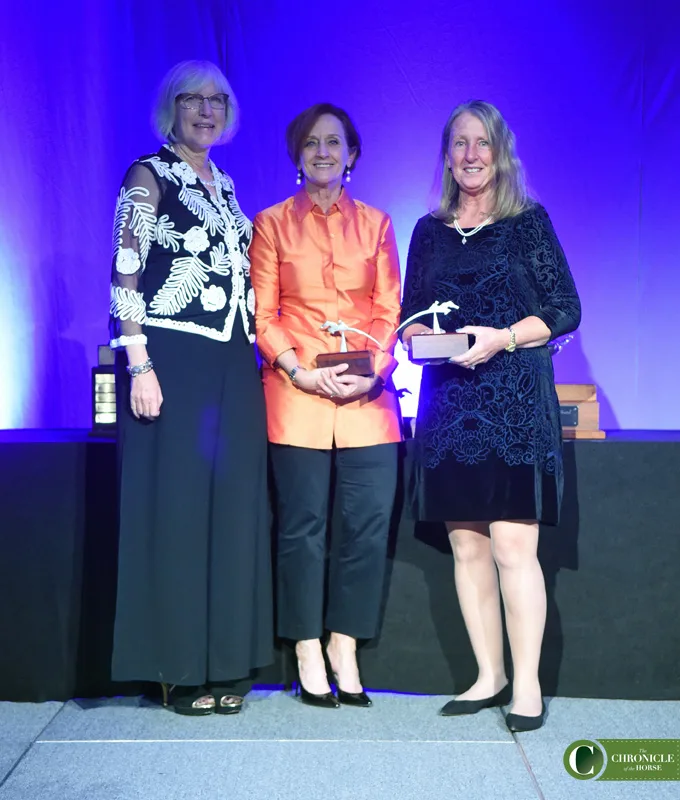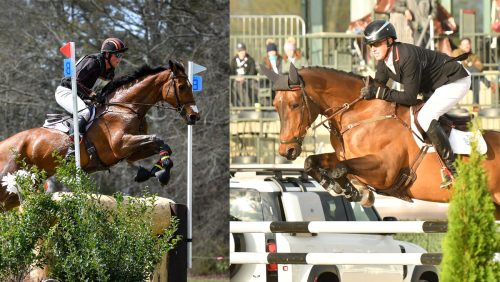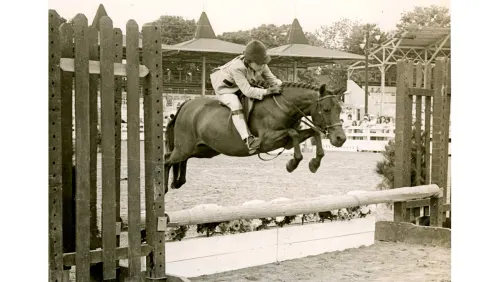Denver—Dec. 12
Every Monday at 5 p.m. since March, Sissy Wickes, Britt McCormick, Andrew Philbrick, Cheryl Rubenstein and Skip Thornbury have had a standing date with U.S. Hunter Jumper Association President Mary Babick. That planning committee was tasked with drilling down on a variety of big-picture topics affecting the USHJA, including rewriting the mission and vision statements. One of their biggest topics of conversation? Restructuring the board of directors.
“We got into a very deep dive on the board structure, what works and what doesn’t,” said Wickes. “We tried to figure out what would make the board more efficient. We ended up talking about a reduced board; it’s a fairly large board right now, and a lot of it is just cumbersome. We talked about the importance of sport growth and the importance of a greater representation of all levels. The top of the roots, middle of the roots, bottom of the roots all need to have access to decision making and transparency. I think that there’s a very big disenfranchised segment of our sport that feel like we’re not responsive to them, that we as government aren’t responsive to them, that we’re not building programs for them or hearing their voices or however you want to put it. We felt it was very important to give affiliates and zones a seat at the table.”

USHJA President Mary Babick discusses the changes being made during the State Of The Association meeting. Kimberly Loushin Photos
So at this year’s USHJA Annual Meeting, Babick announced the changes to the board that are coming down the pipeline. Starting next year there will be one seat on the board reserved for an amateur and another for a competition manager. In 2021 four seats held by Hunter Working Group and Jumper Working Group members will be reassigned to a hunter athlete, jumper athlete, zone representative and affiliate representative. The following year the rest of the working group seats will be eliminated, and the secretary and treasurer seats will be combined, leaving the board with 17 members, down from the current 22.
“We’d outgrown the structure as it was initially designed,” said Wickes. “I think we did leave a certain section of our sport in the weeds as the top of it grew. We addressed that, and I think the board restructure is really exciting. I think that people feel more empowered and more represented and that our programs will reflect such.”
USHJA Child/Adult Hunter Championships On Hold
Many members were shocked to learn that the USHJA Children’s and Adult Amateur Hunter Championships were put on hiatus and will not return until at least 2021. Last month, the board did not approve the funds for the championships due to lack of participation and a financial deficit.
So the Children’s/Adult Hunter Task Force, led by Tobey McWilliams, is looking to revamp the program by adding children’s pony and potentially 2’6″ levels for juniors and adults. Other changes include temporarily lowering qualifications until interest increases, lifting restrictions on cross-entry with the regular horse show, and the requirement that only the championship rider may ride that horse.
“I want more people to do programs,” said Deloise Noble-Strong, a Maryland-based trainer who has served as a team chef d’equipe. “I was gutted when I heard it was going to be on hold. You have to be able to turn to membership and say, ‘Help us.’ If they open it to the 2’6″ and it takes off, we’ll give them their own championship. I can guarantee we aren’t turning away, nor will we if the child/adult becomes so popular that we’re sending too many teams. I don’t see that happening for maybe 20 years, but right now we need to keep it open, open, open.”

Mary Babick (left) presented the President’s Distinguished Service Awards to Charlotte Skinner-Robson and Robin Rost Brown.
Beginnings Of Young Jumper Championships
ADVERTISEMENT
For years there have been rumblings over creating a national championship for the young jumper divisions, but little headway had been made. After it was brought up yet again at last year’s convention, current Young Jumper Task Force Chair Jason McArdle, decided to bring that idea to fruition.
Modeled after some of the European championships and the hunter programs that collect enrollment fees, the championship would include classes for 4-, 5-, 6-, 7- and 8-year-olds. While the older divisions would follow a more traditional format, the 4-year-old division would be a judged competition with style and jumping points awarded for each round. The specifications for the championship still need to be approved by the USHJA board of directors and then the U.S. Equestrian Federation.
McArdle said that the program won’t replace the standalone competitions put on by shows across different parts of the country, but would hopefully build on that.
“Originally we thought, ‘Why don’t we do regionals instead of nationals?’ But there are already those programs that exist, and they’re fantastic,” he said. “We don’t want to take away from that; we still want to encourage people to do those programs, and those programs only enhance the national program.”
Other Conversations
A rule change proposal about how junior hunters are combined and divided passed in the board of directors meeting. Currently the four junior hunter sections can be combined if there are six or fewer in a section. The combined divisions must be split again (usually by a California split) if there are 12 or more riders in a division. This can lead to an awful lot of confusion and unequal ribbons awarded between junior hunter sections, as one combined section of 12 can be double pinned, while another section with many more riders may just get one set of ribbons. After many conversations, junior hunter advocates tweaked the rule change proposal to only combine sections if there are fewer than four in each section. This will lead to fewer sections being combined, and reduce the number of times two sets of ribbons must be awarded.
The trainer certification program is being revamped and is now called the trainer credentialing program. The program will now focus on up-and-coming professionals and will include a wider variety of topics in addition to horsemanship, such as teaching and coaching theory and methodology, safety and injury prevention, sports and business ethics, and athlete physical and psychological growth and development. There will be two tracks to achieve the certification: one track via the USHJA and the other administered through colleges using the USHJA curriculum.
Two versions of a rule that addressed USEF Horse of the Year points for green incentive classes earned plenty of conversation. The debate centered on whether those classes, which tend to have more prize money—especially the championship—could unfairly skew the standings. There was also debate over whether horses should have to show in the division a minimum of five times before the points count toward HOTY awards, with the consensus eventually coming to yes, they should. In the end, the board of directors voted to table the rules for more study on how the points affect the green hunter divisions.
Another major conversation centered on whether or not 3’ and 3’3” green hunters should continue to be required to jog. Many pointed out that these divisions can get quite large, and horses may be waiting all day to jog—a horse welfare issue. The problem with simply getting rid of the jog is that the divisions may be combined with the 3’6” green hunters, which must jog. Several participants pointed out that it’s not fair for the 3’ and 3’3” green hunters to jog sometimes but not always, and it also wouldn’t be fair to combine the divisions and have the 3’ or 3’3” green hunters not jog while the 3’6” competitors must. Conversation turned to whether they should remove the ability to combine with the 3’6”. In the end, the board voted to table the rule to look at whether they should change another rule to disallow combining the 3’ and 3’3” hunters with the 3’6” hunters.
A rule that would have changed the age at which ponies may receive a standard card (from 8 to 6, the same as it was several years ago) was tabled for further discussion. The issue is one part of the rule that states that if the pony is measured multiple times over the years and measures a different height, the higher height will be used. USEF representatives would prefer that instead the final height be used, whether it was higher or lower. The rule was tabled so that the changes could be made appropriately.
ADVERTISEMENT
Rule Change Highlights
All rule changes voted on by the USHJA board of directors now move forward to the U.S. Equestrian Federation board, who will vote on them at their mid-year meeting.
- A rule change requiring horse shows to report to USEF any horse put into isolation at the competition or that departs the competition to receive treatment for a potential infectious disease passed.
- A series of rule changes overhauling the young hunter section passed. The new rules rename the young hunters to “young hunter, 5 and under,” “young hunter, 6 and under,” and “young hunter, 7 and under.” The rules also lower the height in the young hunter sections, allowing horses to begin competing in a young hunter section without it affecting a horse’s green status. (The heights are 2’9”, 3’0” and 3’3” respectively.) They also allow the young hunter section to run concurrently with a green hunter section, allowing horses eligible to show in both green and young hunters to show in one class but receive two awards. The proposals also loosen the eligibility requirements to compete in young hunter divisions.
- A rule that would have awarded points according to the placing received based on the total number of entries (rather than using the increment system) failed to pass.
- A rule that would have loosened restrictions on reinstating a pony’s green status failed to pass.
- A rule banning the use of bisphosphonates in horses 4 and under and allowing the use of bisphosphonates only for treatment of navicular disease failed to pass.
- A rule requiring national and premier horse shows to have privacy screens available in case of catastrophe passed.
- A rule passed that allows horses to compete in any hunter or equitation class at 3’6” or higher for which it is eligible four times prior to Aug. 1 in their 3’9” green hunter year and remain eligible to defer their 3’9” green hunter year to another year one time only.
- A rule passed regarding how equitation championships are calculated. They now mirror how hunter championships are calculated.
- Two proposals that would have required deeper and wider jump cups than the FEI-approved safety cups failed to pass. There was concern about the availability of the proposed cups.
- Several rules creating a new level of certification for course designers at regional I and II shows passed.
- A rule requiring judges in hunter classes to work competitors in groups of 20 or fewer passed.
- A rule requiring jumps at equitation finals to be numbered did not pass.
• A proposal to create a small jumper division failed to pass.
• A rule allowing any junior rider to ride a junior hunter under saddle passed.
• A rule passed banning belly bands and nose nets in the hunters.
• A rule removing a barrier to reporting abuse and providing an opportunity to sanction those who engage in retaliatory conduct passed.
• A rule change allowing detomidine (i.e. Dormosedan) in certain circumstances failed to pass.
• A rule requiring horses to wear numbers at all times while on the showgrounds failed to pass.
• A rule that would have prohibited penalizing hunters with unshaven muzzles failed to pass.
• A rule that proposed allowing boots in the hunters failed to pass.
For a full report from the USHJA Annual Meeting check out the January 13 issue of The Chronicle of the Horse magazine.
















